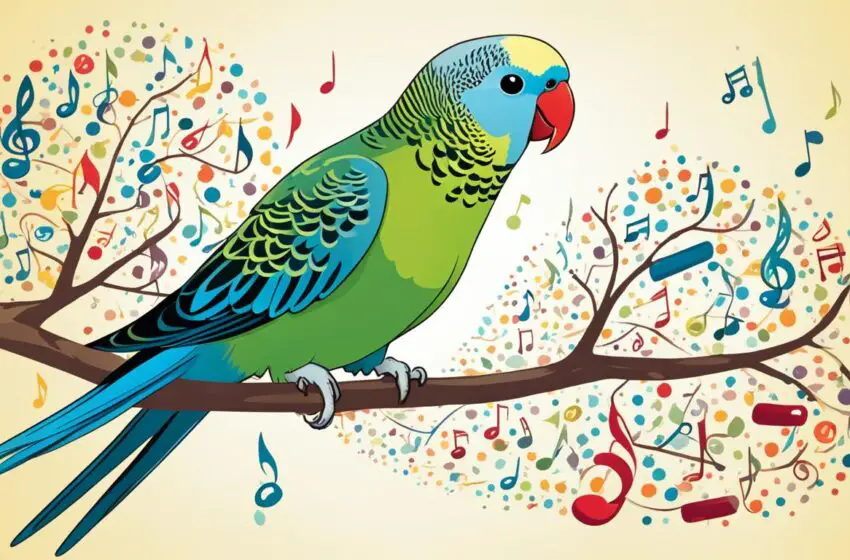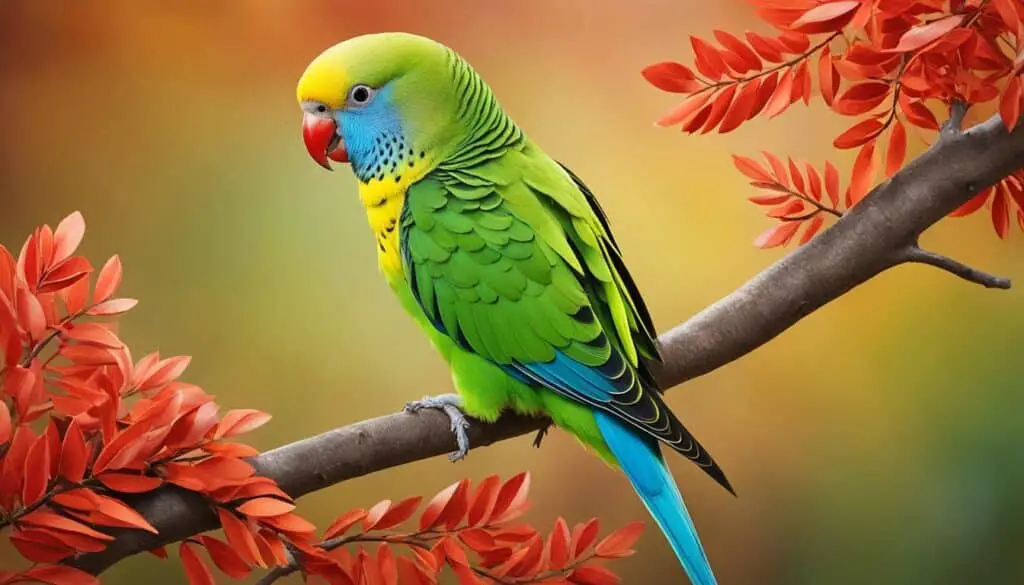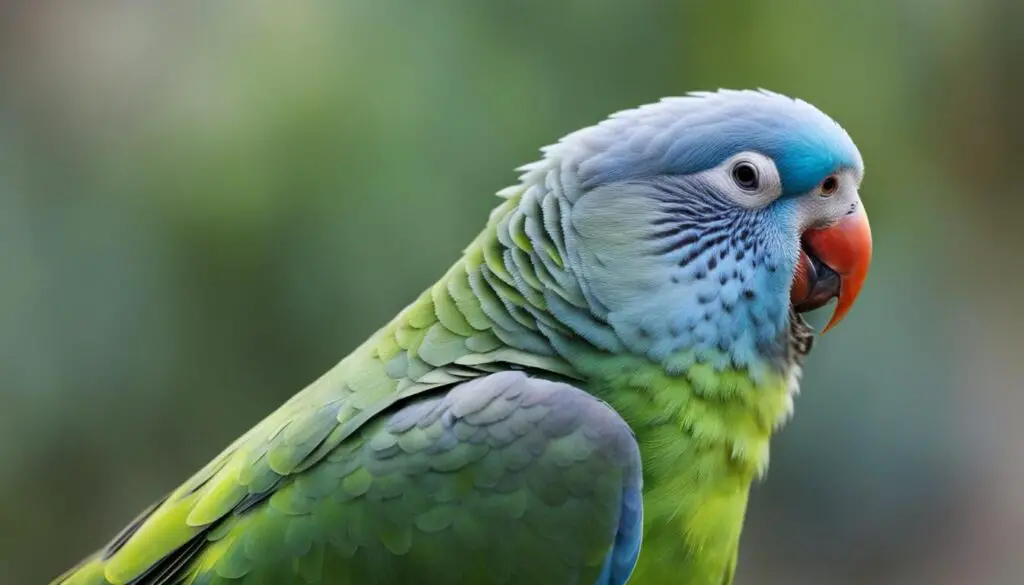Decoding Parakeet Vocalizations: What They Mean

Understanding the vocalizations of your parakeet can provide valuable insights into their emotions, needs, and overall well-being. Parakeets are known for their diverse range of sounds, from chirps to squawks to trills. By interpreting these vocalizations, you can better communicate with your feathered friend and ensure their happiness and health.
Parakeet vocalizations serve as a form of language, allowing them to express various messages. Whether it’s conveying their emotional state or signaling their needs, each sound carries meaning. As a responsible parakeet owner, it’s important to pay close attention to the different types of vocalizations your parakeet makes in order to decipher their language effectively.
Key Takeaways:
- Parakeet vocalizations are a form of language that conveys emotions, needs, and health status.
- Chirping, squawking, and trilling are common vocalizations that parakeets use to communicate.
- Understanding the different patterns and variations in vocalizations can help you respond appropriately to your parakeet’s needs.
- Changes in vocalizations can indicate potential health issues, requiring prompt attention and possible veterinary consultation.
- Providing a safe and stimulating environment is crucial for your parakeet to express themselves through vocalizations.
Types of Parakeet Vocalizations
Parakeets have a remarkable ability to communicate through various vocalizations. Understanding these different types of vocalizations is essential in deciphering your parakeet’s emotions and needs. Let’s explore the three primary parakeet vocalizations: chirping, squawking, and trilling.
Chirping: Signs of Contentment and Happiness
Chirping is the most common parakeet vocalization, often associated with contentment and happiness. It’s characterized by short, rapid sounds that can vary in pitch and intensity. When your parakeet chirps, accompanied by a playful demeanor or fluttering wings, it indicates a joyful and relaxed state of mind.
Parakeet Chirping Patterns:
| Chirping Pattern | Meaning |
|---|---|
| Short, rapid chirps with fluttering wings | Contentment and happiness |
| Sustained, repetitive chirping | Relaxation and satisfaction |
Squawking: An Expression of Distress or Warning
Squawking is a louder and more urgent vocalization that signifies distress, danger, or a warning. When your parakeet squawks, it’s important to pay attention and investigate the cause. It could indicate discomfort in their environment, perceived threats, or an attempt to communicate an urgent message to you.
Parakeet Squawking:
| Squawking Behavior | Meaning |
|---|---|
| Loud and continuous squawking | Distress, fear, or danger |
| Repetitive squawks with aggressive body language | Warning or territorial display |
Trilling: Melodic Sounds of Excitement and Playfulness
Trilling is a delightful and melodic vocalization that parakeets use to express excitement, happiness, and playfulness. It involves rapid, musical sounds created by the bird’s tongue rapidly moving against the roof of its mouth. Trilling often occurs during moments of interaction and joy, enhancing the bond between you and your parakeet.
Parakeet Trills:
| Trilling Behavior | Meaning |
|---|---|
| Rapid, melodic trills | Excitement and happiness |
| Trills accompanied by playful behavior | Expressing affection and joy |
By recognizing and understanding these different vocalizations, you can decipher your parakeet’s emotions and needs more effectively. Pay attention to the patterns, context, and accompanying behaviors to develop a deeper bond with your feathered friend.
Interpreting Parakeet Chirping
Parakeet chirping is one of the most common vocalizations exhibited by these colorful birds. The different patterns and variations in chirping can convey a wide range of meanings, enabling us to better understand and communicate with our parakeet companions.
Short, rapid chirping is often a sign of excitement or happiness in a parakeet. You may notice your parakeet chirping in this manner when they are engaged in play, flapping their wings, or exhibiting a playful demeanor. It’s their way of expressing their joy and enthusiasm. When you see and hear this type of chirping, it’s a positive indication that your parakeet is content and thriving.
On the other hand, slow, repetitive chirping can indicate contentment and relaxation in parakeets. It is commonly observed when they are in a peaceful state, perhaps while perched or resting. This gentle form of chirping signifies calmness and tranquility, suggesting that your parakeet is at ease in its environment.
However, it’s important to be attentive to prolonged and continuous chirping, as it may stem from discomfort, boredom, or the need for attention. If your parakeet is chirping persistently without any apparent reason, it could be a signal that something is amiss. They might be experiencing physical discomfort, longing for mental stimulation, or seeking interaction with you. By recognizing these patterns in their chirping, you can respond appropriately and provide the necessary care and engagement.
To better understand your parakeet’s chirping patterns, spend time observing their behavior and noting any contextual cues. Pay attention to the frequency, duration, and intensity of their chirping, as well as their body language and overall demeanor. Over time, you’ll develop a deeper understanding of your parakeet’s individual communication style and be able to interpret their chirping more accurately.
Remember, your parakeet’s chirping is a form of communication, and by actively listening and responding, you can strengthen the bond between you and your feathered friend.

Key Points:
- Short, rapid chirping indicates excitement and happiness.
- Slow, repetitive chirping signifies contentment and relaxation.
- Prolonged and continuous chirping may indicate discomfort or the need for attention.
- Observe contextual cues and note the frequency, duration, and intensity of your parakeet’s chirping.
- Actively listen and respond to your parakeet’s chirping to strengthen your bond.
Deciphering Parakeet Squawking
Parakeet squawking is one of the most distinctive vocalizations that these vibrant birds make. It is generally louder and more urgent compared to their chirping or trilling sounds. Squawking can signify different emotions and messages, such as distress, fear, or a warning. If your parakeet is squawking loudly and persistently, it is essential to investigate the cause behind this behavior.
Squawking sounds can indicate that your parakeet is experiencing discomfort or anxiety in their environment. It could be a response to perceived danger, the presence of a predator nearby, or an unfamiliar object or noise. By identifying the triggers that lead to squawking and addressing the underlying cause, you can help alleviate your parakeet’s anxiety and create a safe and calm atmosphere for them.
When deciphering squawking patterns, pay attention to the surrounding circumstances and your parakeet’s body language. Are they flapping their wings aggressively, crouching or moving in a defensive manner? These behavioral cues can provide important context to understand the message behind the squawking sounds.
Responding to Parakeet Squawking
When your parakeet is squawking, it is crucial to remain calm and avoid making sudden movements or loud noises that may further agitate them. Instead, speak softly and reassuringly to your parakeet to let them know that you are nearby. You can also try to identify and remove any potential sources of discomfort or fear in their environment.
Creating a safe and enriching living space for your parakeet is pivotal in preventing excessive squawking. Ensure that their cage is properly sized, clean, and filled with toys, perches, and other stimulating elements. This can help keep your parakeet engaged and reduce their stress levels.
Remember, building trust and a strong bond with your parakeet takes time and patience. By responding empathetically to their squawking sounds and addressing their needs, you can foster a harmonious relationship with your feathered companion.
“Understanding the meaning behind your parakeet’s squawking can help you meet their needs, ensure their well-being, and strengthen your communication with each other.” – [Author]
| Squawking Characteristic | Meaning |
|---|---|
| High-pitched and continuous | Signifies distress or fear |
| Loud and repetitive | Potential response to a perceived threat or danger |
| Accompanied by defensive behavior | Indicates a warning to potential threats |
| Variations in pitch and intensity | May reflect different levels of discomfort or agitation |
Understanding Parakeet Trills
Parakeet trilling is a delightful and melodious vocalization that often indicates happiness, excitement, or affection. Trills are characterized by rapid and musical sounds produced by rapidly moving the tongue against the roof of the bird’s mouth.
Parakeets may trill when they are playing, interacting with their owners, or expressing contentment. This joyful vocalization adds a sweet and vibrant melody to your parakeet’s repertoire, enhancing the overall atmosphere of your home.
Trilling is a form of communication that parakeets use to express their positive emotions. It is a sign of their well-being and contentment in their environment. When your parakeet trills, it shows that they feel safe, secure, and happy in their surroundings.

To encourage your parakeet to trill, create a stimulating environment with plenty of toys and opportunities for play. Interact with your bird regularly, offering them attention, affection, and positive reinforcement. When your parakeet engages in trilling, respond with enthusiasm and praise to reinforce this behavior.
Trilling is also a way for parakeets to bond with their owners. When they trill, they are expressing their affection and trust. By recognizing the positive nature of trilling, you can further deepen your bond with your parakeet and strengthen your relationship.
Listening to your parakeet’s trills can be a source of joy and entertainment. It’s a special sound that brings charm and liveliness into your home. Enjoy the symphony of trilling sounds as your parakeet expresses their happiness and appreciation for their environment and your companionship.
Taking Note of Vocalization Changes
It’s essential to pay attention to any changes in your parakeet’s vocalizations, as they can indicate potential health issues. If your parakeet’s chirps, squawks, or trills suddenly become weaker, more frequent, or exhibit other abnormalities, it could be a sign of discomfort, illness, or pain. Consult a veterinarian if you notice significant changes in your parakeet’s vocalizations along with other symptoms such as lethargy or loss of appetite. Regular observation and awareness of vocalization changes can help ensure the well-being of your feathered companion.
| Common Vocalization Changes | Potential Health Issues |
|---|---|
| Weaker or softer vocalizations | Potential respiratory or throat infections |
| More frequent or prolonged vocalizations | Potential discomfort or pain |
| Unusual or abnormal vocalization patterns | Potential neurological or hormonal disorders |
| Sudden loss of vocalizations | Potential loss of voice or underlying illness |
Parakeets are masters of communication, and their vocalizations play a vital role in expressing their physical and emotional well-being. Paying close attention to any changes in their vocalizations can provide important insights into their health. Remember, always seek professional veterinary advice if you notice any abnormal vocalizations or accompanying behavioral changes. Your proactive approach to vocalization changes can contribute to a long and happy life for your beloved parakeet.
Conclusion
Understanding parakeet vocalizations is key to effective communication with your feathered companion. Parakeets have a diverse range of vocalizations, including chirping, squawking, and trilling, each with its own unique meanings and emotions. By carefully observing the patterns and context of their vocalizations, you can decipher their messages and respond accordingly.
Creating a safe and enriching environment for your parakeet is crucial for fostering open communication. Providing plenty of toys, social interaction, and mental stimulation can help your parakeet express themselves through their vibrant vocalizations. Remember, chirping can indicate happiness, trilling signifies excitement or affection, while squawking may signal distress or a warning.
Paying close attention to any changes in your parakeet’s vocalizations is also important. Abrupt changes in their chirping, squawking, or trilling patterns can be a sign of underlying health issues that require veterinary attention. Regular observation and awareness of vocalization changes can ensure the well-being of your parakeet.
By understanding and interpreting your parakeet’s vocalizations, you can strengthen your bond, improve communication, and provide a loving and nurturing environment for your feathered friend.
FAQ
What do parakeet vocalizations mean?
Parakeet vocalizations can convey messages about their emotional state, needs, and even their health.
What are the different types of parakeet vocalizations?
Parakeets utilize a range of vocalizations, including chirping, squawking, and trilling.
What does chirping indicate in parakeets?
Chirping can indicate excitement, happiness, contentment, relaxation, discomfort, boredom, or the need for attention.
What does squawking signify in parakeets?
Squawking often signifies distress, fear, or a warning.
What does trilling indicate in parakeets?
Trilling indicates happiness, excitement, or affection.
Why is it important to pay attention to vocalization changes in parakeets?
Vocalization changes can indicate potential health issues, discomfort, illness, or pain in parakeets.



